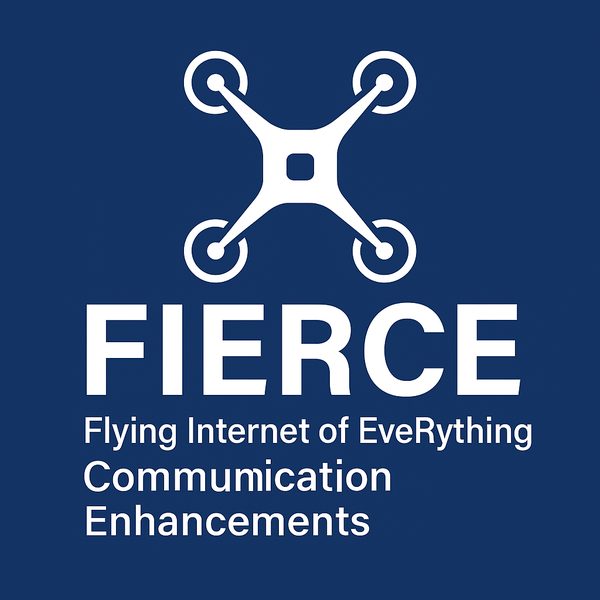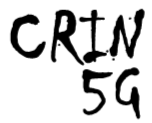Research Projects
 |
FIERCE: "Flying Internet of EveRything Communication Enhancements" (PID2022-142105OB-I00) |
|---|---|
| Funding : | Spanish Government ( 143.750 €) |
| Duration : | September 2023 to September 2026 |
| Principal Investigator: | David Pérez Díaz de Cerio y Mario García Lozano |
| Overview: |
This project aims to propose advances and disruptive solutions in wireless communications within the drone context. Drones represent a novel type of aerial user that must be integrated into existing infrastructures, either directly or through inter-drone communication strategies. They can also function as flying base stations or mobile cooperative relays with varying levels of intelligence, ranging from distributed units handling only physical layer procedures to complete solutions capable of bringing computing services closer to the edge. This project addresses challenges arising from the need for sky connectivity:
|
 |
CRIN-5G-UPC: "Cloud Robotics and the Impact of 5G Networks in the Factory of the Future" (RTI2018-099880-B-C32) |
|---|---|
| Funding : | Spanish Government (176.055 €) |
| Duration : | January 2019 to December 2021 |
| Principal Investigator: | Mario García Lozano |
| Overview: |
CRIN-5G-UPC is a coordinated project with UPV aiming at improve the integration of 5G networks and complementary technologies into the factory of the future. UPC's objectives are:
|
DEFINE-5G-UPC: "Developing Future Architectures and Technologies towards 5G Networks, UPC" (TEC2014-60258-C2-2-R) |
|
|---|---|
| Funding : | Spanish Government (171.457 €) |
| Duration : | January 2015 to September 2018 |
| Principal Investigator: | Mario García Lozano |
| Overview: |
DEFINE-5G started in a period in which candidate technologies are being evaluated for the future 5G mobile communications systems. In this context, the main objectives of the project are:
|
GEOCOM: "Green Efficient Mobile Communications" (TEC2011-27723-C02-01) |
|
|---|---|
| Funding : | Spanish Government (198.319 €) |
| Duration : | January 2012 to December 2014 |
| Principal Investigator: | Joan Olmos Bonafé |
| Overview: |
The main objective of this Project is to improve the ubiquity of high quality user experience in cellular mobile radio communications systems while minimizing the resource consumption and the impact on the current 3GPP LTE Release 10 network architecture. Broadcast/multicast techniques need also be considered to improve the spectral efficiency. These advances create the need for new evaluation methodologies, new link to system mapping methodologies and new specific reference scenarios. In order to accomplish the project main objective, the following partial objectives have been defined: 1. To provide solutions that facilitate the deployment of lightweight communications network infrastructure through the usage of advanced relays: fixed, mobile and portable. 2. To investigate on scalable solutions (semi- or fully-distributed) to achieve a maximum performance of HetNets deployments. 3. To integrate the capabilities of the 3GPP LTE-Advanced broadcasting transmission mode (E-MBMS) into the coordinated access network for the provision of mass market multimedia services. 4. To study and develop adequate guidelines and software tools for 4G and beyond 4G radio access network optimisation with the objective of achieving ubiquitous QoS 5. To consolidate the innovations from objectives 1/2/3/4, including the overall performance evaluation of the developed technologies and their integration in the LTE-A roadmap. |
 |
GREENET "An Early Stage Training Network in Enabling Technologies for Green Radio" (FP7-264759) |
|---|---|
| Funding : | UE FP7 Marie Curie |
| Duration : | January 2011 to December 2014 |
| Principal Investigator: | Luis G. Alonso Zárate |
| Overview: | Greenet is an Initial Training Network (ITN) Marie Curie project that is focused on the analysis, design and optimization of energy efficient wireless communication systems and networks. It will create a fully-integrated and multi-disciplinary network of 17 Early Stage Researchers (ESRs) working in 10 first-class institutions distributed in 7 European countries. The consortium is formed by 3 Universities, 3 Research Centeres and 4 Private Companies. this Network will offer to a group of newly recruited ESRs a cross-sectorial environment to shape their long-term research view and get fundamental methodological tools on various research fields such as: cooperative communications, cognitive networks and network coding. |
| +info : | More information at www.fp7-greenet.eu/default.htm |
 |
COST IC1004 "Cooperative Radio Communications for Green Smart Environments" |
|---|---|
| Funding : | EU |
| Duration : | May 2011 to end 2014 |
| Principal Investigator: | Silvia Ruiz Boqué (Spanish delegate) |
| Overview: | Smart Environments (SEs), like the human body, energy efficient buildings, vehicular or urban environments, are populated by many devices connected by wireless networks. The radio channel is central to SEs, as it impacts the design of transmission techniques and communication protocols. Radio communications in SEs need to be green and based on cooperative paradigms to mitigate the effect of interference and improve efficiency. This Action addresses research issues in the field of cooperative radio communications to make our society cleaner, safer, and more energy efficient. The main goal of the Action is to increase knowledge of cooperative communications applied to Green SEs (GSEs), by exploring and developing new methods, models, techniques, strategies and tools, in a context enriched by deep industry-academia links. Training of young researchers is also one of its main objectives, to be pursued e.g. via annual training schools. Europe will benefit from the activities of this Action, as GSEs will be one of the key components of the broader field (and exploding market) of the Internet of Things, a domain of interest to many large and small companies in Europe. COST is the ideal framework, as it allows very efficient cooperation among industries and academia. WiComTec participates in COST IC1004 Action being professor Silvia Ruiz one of the two Spanish Delegates nominated by the Spanish Ministry, as well as the UPC contact coordinator. Three times per year a meeting is organized where WiComTec researchers discuss their recent advances with other european colleagues working on the same subjects. |
| +info : | More information can be found at www.cost.eu/ict |
 |
HELP4MOOD: "A Computational Distributed System to Support the Treatment of Patients with Major Depression" |
|---|---|
| Funding : | EU through 7th FWP (Seventh Framework Programme Area: Personal Health Systems (ICT-2009.5.1) |
| Duration : | January 2011 to December 2013 |
| Principal Investigator: | Silvia Ruiz Boqué |
| Overview: | Depression is one of the most common causes of short and long term disability in Europe. It accounts for substantial costs both directly to health services and indirectly through lost productivity and the burden of caring. Most patients with Major Depression (MD) recover with treatment, which may be with antidepressant drugs, psychological therapy or, in severe cases, hospitalisation. However for many, that recovery is either slow or incomplete. Research shows that psychological therapies can be delivered effectively without face to face contact: computerised cognitive behavioural therapy (CCBT) is suitable for self-guided treatment in the individual's own home. However, its value for patients is limited by the difficulty of staying engaged, and there are professional concerns that important changes in mood may be missed. Help4Mood proposes to significantly advance the state-of-the-art in computerized support for people with MD by monitoring mood, thoughts, physical activity and voice characteristics, prompting adherence to CCBT, and promoting behaviours in response to monitored inputs. These advances will be delivered through a Virtual Agent (VA) which can interact with the patient through a combination of enriched prompts, dialogue, body movements and facial expressions. Monitoring will combine existing (movement sensor, psychological ratings) and novel (voice analysis) technologies, as inputs to a pattern recognition based decision support system for treatment management. The advances in Help4Mood will provide a closed loop approach to treatment support for MD patients. Outputs include: a validated personal monitoring system; a personal interaction system embodied in a VA and a clinical decision support module. By identifying and supporting patients with delayed recovery, Help4Mood has the potential to target added support for patients most in need and lead to their earlier return to normal health and social and economic activity. WiComTec professors David Perez and José Luis Valenzuela are the responsible of the research and implementation of an efficient Wireless Communications Network and protocols to collect the sensor signals sending them to the decision suport system. |
| +info : | More information can be found at cordis.europa.eu/fetch until the HELP4MOOD web site is operative |
 |
CENTENO: "Engineering and Optimization of 3GPP LTE Cellular Networks" (TEC2008-06817-C02-02) |
|---|---|
| Funding : | Spanish Government (202.070 €) |
| Duration : | January 2009 to December 2011 |
| Principal Investigator: | Joan Olmos Bonafé |
| Overview: |
The main objective of this project is to develop the algorithms, software tools and guidelines for the deployment, radio resource allocation, and optimisation of the 3GPP LTE radio access network, following a QoS-centric paradigm and accounting for the key implementation aspects to ensure the applicability of the proposed techniques. In order to accomplish this main objective, the following partial objectives are identified: |
 |
FURIA-1, 2 and 3: "Future Audiovisual Integrated Network" (Combo of 3 projects: FIT-330503-2006-6, TSI-020100-2008-630 and TSI-020301-2009-33) |
|---|---|
| Funding : | Spanish Government (UPC is contracted by Fundació I2Cat) |
| Duration : |
FURIA 1: June 2006 to December 2007 |
| Principal Investigator: | |
| Overview: |
Form a strong Spanish consortium that develops and validates the integration of the emerging technologies for the broadcast of media contents to fix/handheld terminals. Technological objectives:
WiComTec participates in FURIA through a collaboration with i2CAT (http://www.i2cat.net/en) . Our main work is addressed to:
|
| +info : |
More information at http://www.furiapse.com/ingles/index.htm
|
 |
Technology support to Zig-Vic project |
|---|---|
| Funding : | Fundació I2Cat |
| Duration : | June 2009 to July 2010 |
| Principal Investigator: | Mario Garcia Lozano and Silvia Ruiz Boqué |
| Overview: |
WICOMTEC provideD technology support to "Fundació I2Cat" to design and active RFID solution for the General Hospital of Vic. The system is in charge of improving the work of health personnel and the optimal use of resources, along with the accurate identification of the patient. |
 |
COST 2100: "Pervasive Mobile & Ambient Wireless Communications" |
|---|---|
| Funding : |
European Funding
|
| Duration : | December 2006 to December 2010 |
| Principal Investigator: | Silvia Ruiz Boqué (Spanish delegate) |
| Overview: | The main objective of this Action is to increase knowledge of mobile and wireless network technologies, by exploring and developing new methods, models, techniques, strategies and tools that will facilitate the implementation of next generation mobile radio communication systems and will foster the development of the paradigms of pervasive and ambient wireless communications. There are three working groups: WG1: Transmission Techniques and Signal Processing WG2: Radio Channel WG3: Radio Network Aspects. WiComTec has been very active presenting results and collaborating with other researchers from WG3, through joint publications, short term missions, seminars and workshop organization, experts participation, editing chapters of the final COST book. WiComTec is also one of the two official Spanish delegates in the Action. |
| +info : |
More information at http://www.cost2100.org |
 |
MULTIPLATFORM: "Wireless communication multi-platform and specification and implementation of a standard communication protocol, aimed to increment the railway’s infrastructure sensorization, visual control, and the overall transport safety" |
|---|---|
| Funding : | Spanish Government |
| Duration : | January 2009 to September 2011 |
| Principal Investigator: | José Luis Valenzuela and Luis G. Alonso Zarate |
| Overview: | The main purpose of this Project addresses the need to increment the types and coverages of both on board and track detection systems, as well as to ease the on board visual supervision through the implementation of an intelligent video surveillance system. The design and validation of a new wireless communication multi-platform is instrumental to that goal. The multi-platform high level requirements are the following: Facilitate the railway detection systems deployment, by reducing installation and maintenance costs through the use of new, autonomous, wireless communication technologies (short, mid and long ranges). Allow the train-track communications in order to make possible the train video surveillance from the Infrastructure Manager Control Centers. In order to provide an efficient control and management of the multi-platform functionalities, the specification and implementation of a new communication high level protocol is proposed. The project includes a task designed to examine the electromagnetic compatibility of the multi-platform implementation and the railway environment emissions.. Also, it comprises the analysis of the protocol and multi-platform RAMS parameters, in order advance towards the certification of the multi-platform. The multi-platform and protocol implementations are tested through the implementation, divided in two phases, of a prototype: Phase 1: Lab prototype. The phase activities focuses on the measurement and analysis of the network parameters, aiming at validating the correct functioning of the wireless communication equipments. A preliminary validation of the high level application protocol is also included in the phase. Phase 2: Railway environment prototype. The main objective of this second phase is to model and analyze the functional, in-situ behavior of the railway wireless communication multi-platform for the transport from the rolling stock to the Infrastructure Manager Control Center of video and sensor data information. Finally, the main goal of this project is to increase the security of the railway infrastructure, through a widespread, flexible and low cost deployment of railway detection and video surveillance systems, allowing a real time and more accurate supervision along the railway infrastructure, guarantying the highest levels of security to the railway transport. |
 |
COOLNESS: "COoperative transmission and crOss-Layer techNiques for sEcure wireless Sensor networks" |
|---|---|
| Funding : | European Community |
| Duration : | June 2008 to June 2011 |
| Principal Investigator: | Luis G. Alonso Zarate |
| Overview: | This is a Marie Curie IAPP project performed under the coordination of our Research Group where the consortium is formed by the UPC and VIDAVO, a greek private company. The main objectives of the research project include: 1. Definition of a protocol stack architecture able to accommodate a rich variety of sensor devices and applications. 2. Propose Cross-Layer techniques that can be used in order to enhance the efficiency of WSN. 3. Propose new efficient cooperative protocols network coding schemes for WSN. 4. Propose effective, efficient and resilient security techniques to protect the Cross-Layer algorithms and cooperative protocols. 5. Adapt the all the proposed protocols and algorithms to the requirements of healthcare applications. 6. Develop a prototype for demonstrating and validate the feasibility of the proposed approaches. |
| +info : | More information can be found at http:// www.vida24.gr/coolness |
Share: